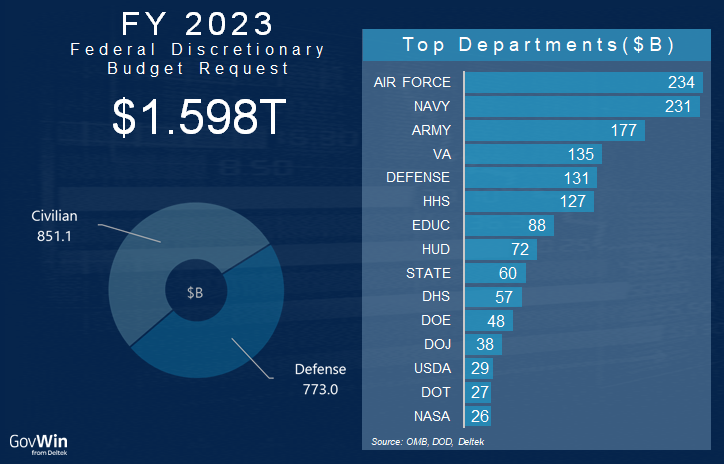The Office of Management and Budget (OMB) has released the Biden Administration’s long-awaited FY 2023 Budget Request, providing funding and program information for federal departments and agencies for the fiscal year.
Deltek’s team of market research experts that support the GovWin IQ solution has been tracking the FY 2023 federal budget request closely, and recently shared some insider tips for federal government contractors related to the budget. In this webinar, now available on demand, Senior Director of Federal Market Analysis Deniece Peterson shared insights on program priorities, planned agency budgets and spending implications, and priority investment areas for the federal government.
In this summary, we set the context for the budget with spending trends from the previous year, take a look at the FY 2023 federal budget, and explain ways that this intelligence can be actionable for government contractors.
A Look Back at 2021 Federal Spending
According to data from Deltek’s GovWin IQ platform, federal government contract spending totaled $629B in the 2021 fiscal year, a slight decline from 2020 but still a significant increase over 2019.
“While overall contract spending dipped slightly (in 2021) compared to 2020, several departments and market segments saw a significant increase in spending, especially from within civilian agencies. This bodes well for federal contractors, many of whom rely on GovWin IQ to give them the early intelligence they need to source, bid and win contracts.”
Kevin Plexico, Senior Vice President of Research, Deltek
The spending information was tracked in Deltek’s GovWin IQ platform, which found that Civilian spending remained mostly steady at $246B, decreasing 0.8% from the $248 mark of 2020, while Defense spending declined 9.2% from 2020, dropping from $422B to $383B. Overall, nearly $5B of the total decline in federal spending came from a reduced amount of spending in responding to the COVID-19 pandemic.
The notable decrease in Defense sector spending was driven by a $40B decrease in contracting by the Navy:
- The Navy decline in spending was driven by a major spike in spending in 2020 on various aircraft, ship and submarine programs that dropped in 2021
- All other military branches were essentially flat
Civilian agency spending was essentially flat collectively, but with some agencies with substantial increases and decreases. Among the more notable increasing agencies were:
- Treasury spending increased 44% driven by purchasing of precious metals
- Interior spending increased 12% related to investments in technology and infrastructure
- State department spending increased 11% due to embassy construction and emergency efforts to relocate people from Afghanistan
Examining the Federal Budget Request for FY 2023
The GovWin Federal Market Analysis team took a detailed look at the available budget details in order to share some of the most noteworthy items in the FY 2023 budget request. The team, comprised of market experts on all aspects of federal government contracting, reviewed the largest federal departments’ budgets to get a sense of direction and priorities for FY 2023, which will begin October 1, 2022. Below is a graphic that summarizes the budget request.
Defense spending is heavily prioritized in the FY 2023 federal budget request. The request proposes a $64B increase for the Department of Defense over the previous budget. Some of the other areas that are prioritized for funding increases are cybersecurity, veteran care, research and development, public health infrastructure and preparedness, climate change and resilience.
Additionally, the budget emphasizes a stronger focus on providing equity to small businesses. The request directs an increase in SBD (small disadvantaged business) contract awards to a total of 15% of federal contract spend by 2025. Small businesses can download this free Federal Small Business Opportunities & Trends for 2022 report to learn how to take advantage of this trend towards increased federal government small business spending.
Top 3 Departments in the FY 2023 Federal Budget Request
The three departments below had the most funding allocated in the 2023 budget:
- Air Force: The president’s budget request provides $234.1B in total discretionary funding for the Department of the Air Force (USAF), a 14.5% increase over the FY 2021 enacted level. This includes $24.5B for the U.S. Space Force (USSF) for FY 2023, a $9.1B increase over the FY 2021 enacted level.
- Navy: The president’s budget requests $230.9 for the Department of the Navy, an increase of $24B (11.6%) from the FY 2021 enacted level.
- Army: The president’s budget requests $172.7B in discretionary funding for the Department of the Army, 1.0% less than enacted for Fiscal Year 2021.
Next Steps for Federal Government Contractors to Take
To enable federal government contractors to act on previous spending trends and projected budget items going forward, the GovWin IQ team has provided a report that will help them to identify early stage opportunities, plan strategically and navigate the competitive landscape.
In the new report, FY 2023 Federal Budget Request: Priorities and Opportunities, GovWin’s federal market experts analyze proposed program investments and policy directives within the Biden Administration’s $1.6T fiscal year (FY) 2023 discretionary budget request, and provide recommendations for federal government contractors to win more federal government contracts.

Deltek Project Nation Newsletter
Subscribe to receive the latest news and best practices across a range of relevant topics and industries.


